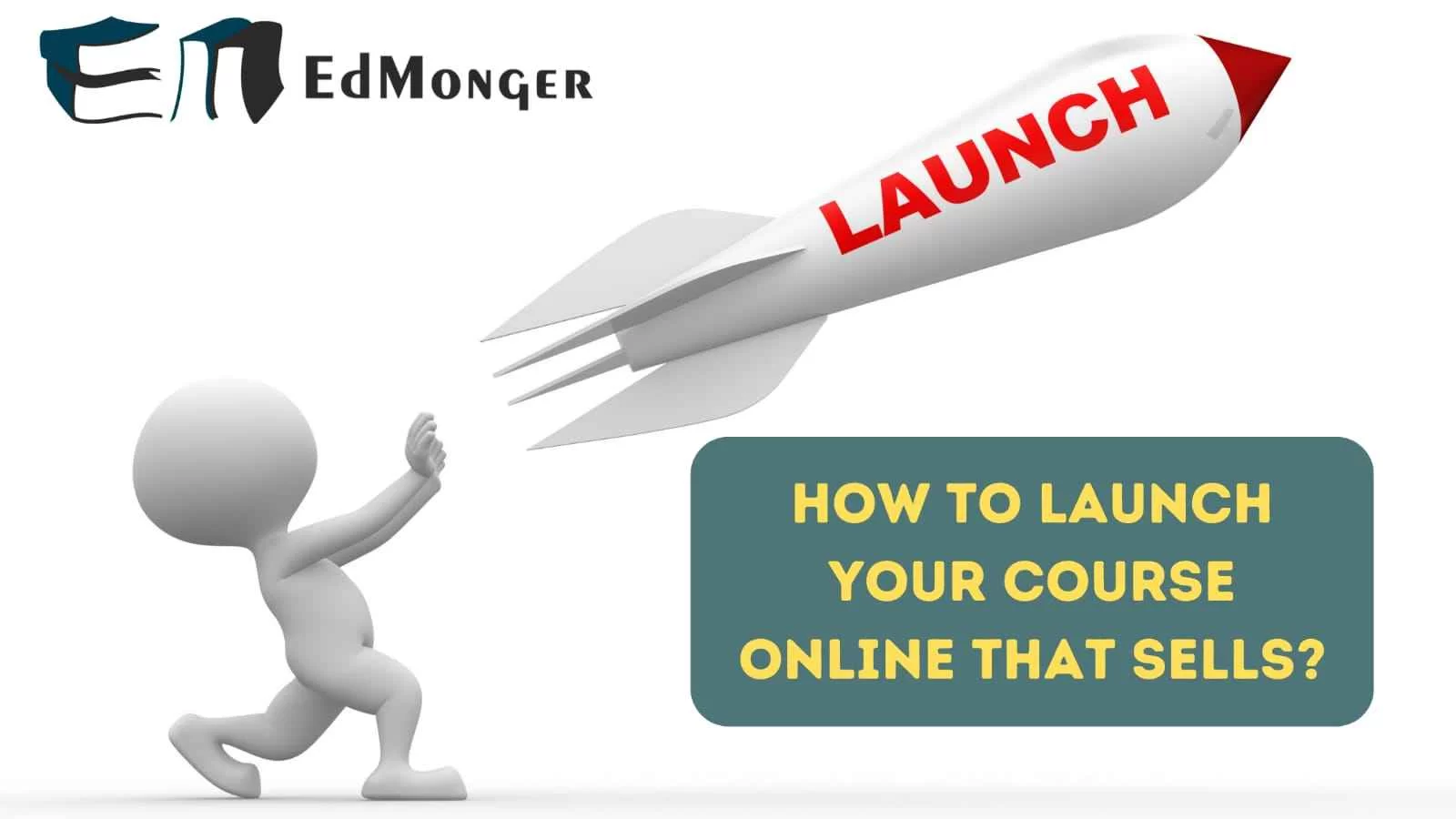If you are planning to launch an online course or want to become a course creator, you are certainly aware of the important things to consider while launching an online course for maximum reach.
An online course creation and the launch online course are two distinct processes. You must consider both factors if you want to succeed in the online education market.
You could have created the best online course, but you might face challenges in getting it sold in the market, and you also might need more of a splash to get people’s attention. Let these things aside, what about market competition? We have yet to include this point in the challenges.
So, a lot of things are there to consider while launching a successful online course.
In this article, we’ll explain how you should create an online course and its launch plan if you, too, want your online course to start and succeed with a boom. Besides, we will explain how to create an online course from scratch and how to sell online courses effectively to your target audience.
Let’s get started..!!
How Starting an Online Course Can Help You Reach Your Career Goals?
There has been tremendous growth in the online community since the digital revolution. More and more people are using the internet to meet new people and do business. If you are in the education industry or are considering entering the online education market, this is the ideal time to enter and offer the best possible online course.
People are becoming increasingly adapted to learning online as the online world expands. And we saw how all the schools and universities in Corona were shut down, forcing everyone to turn to distance learning. And even as things have begun to stabilize, more and more students are choosing to pursue their education entirely through online channels.
And now that there is such a high demand for online courses, if you also launch online courses in the market, you will reap many benefits in the future.
Let’s have a look at the online learning stats we have collected from various resources.
Online Learning Stats 2023
Online education has come a long way from its initial days, and estimates put the industry size at $325 billion by 2025.
- The online education market is growing yearly at 20%, with the largest consumer market being Asia.
- 60% of people resort to online learning, as it gives them the freedom to choose a time and place.
- Most businesses (80%) and students (50%) in higher education institutions have employed an online learning system.
- It has been estimated that employees and students may save between 40 and 60 per cent of their time by switching to an e-learning program.
You must have realized by now how popular online courses will be in the future. To those who are considering this as a potential career option, now is the time to be ready and get started.
So the question is, “How to launch an online course”?
Here is the online course launch guide for you..!!
How To Launch Online Course?
Find The Perfect Course Topic For Your Audience
Before launching any course, you have to see whether your interest is in that particular subject; first of all, evaluate yourself, what are your interest types, which subject you find close to your heart, and which subject You enjoy getting in-depth information about. Once you’ve assessed your options, you’ll have a subject to work on.
Apart from this, you also have to research how many courses in that subject are available in the market or how many competitors you have and what they offer.
Then think about who you’re launching an online course for. Who is the target audience for this course? Who would be interested in signing up for this course? Considering these criteria can help you select a winning topic for your course.
After deciding on a topic, the next step is to select an appropriate format and a hosting platform.
Pick The Appropriate Format And Platform
When creating online courses, you have several different presentation options and hosting platforms to select to make your course accessible to students. The most important ones are those based on the video, followed by audio, and finally, the text format.
Always customize your online course based on your target audience. Let us show you how different formats cater to the needs of different audiences.
- Video Course – Individuals enjoy watching videos quite much. So video courses are very popular these days; they are simple to create and easy to learn from.
- Audio Course – Learners who are constantly on the move and don’t have the time to sit down and view videos may benefit greatly from taking audio courses.
- Text-based Course – People who enjoy reading text formats, as well as those who enjoy reading in general, find this course enjoyable and choose to enrol in it.
In addition to this, you will need to select a platform on which to host your course. There are many different platforms available for taking online courses, so it is important to spend some time researching the many possibilities available to you.
When choosing the right online course platform, you should consider factors such as cost, functionality, flexibility, and simplicity of operation.
And as per our research, Thinkific is the perfect and the best online course platform to provide value and quality.
Thinkific is the solution that helps course creators develop and sell online courses. Besides, this platform’s User Interface (UI) and User Experience (UX) are fantastic. Whether you are a beginner or an experienced course creator, once you use Thinkific, you will admire its simplicity.
Online Course Creation
When developing a course, you should always keep these two questions in mind: why would someone buy your course, and what does your course provide that other courses on the market cannot?
You may offer value to the readers of your course by making it as straightforward and helpful as possible. Instead of copying a course that already exists, you should tailor yours to your readers’ experience level and educational background. Always keep in mind the requirements of the end user.
In addition, you should make your course interesting and use terminology that is easy to understand. You may need a lot of time to create such a robust course, but remember that this course will benefit you greatly in the coming times.
Set The Right Price For Your Online Course
Setting a price for an online course might be difficult. You don’t want to price yourself out of the market by charging too much, but you also don’t want to undercharge and lose revenue.
Keep the following things in mind while setting the price of your online course.
- Value Deliverance – Online courses can be priced according to the benefits they offer to students. This may be done by checking the market pricing. Specifically, you should consider the costs your rivals are asking for to provide the same services. You’re free to charge more if you know your course is superior.
- The Course Duration – The cost of your online course will naturally increase in proportion to the length of the course you are offering.
- Target Audience – If your target customers are experienced and well-versed, you may charge extra for an advanced course that caters to them. And if your target market consists primarily of newcomers, you may price your beginner online course accordingly.
Course Distribution And Promotion
Getting the word out about your online class may be done in various ways. Nevertheless, not all forms of promotion are made equal. Some approaches are more fruitful than others in terms of their overall results.
Here are the best strategies to promote online courses.
- Social Media
Reaching out to learners interested in your online class using this platform is a fantastic opportunity. Use social media to publish about your class and give useful advice connected to the subject you’re instructing on. You can use Instagram, Facebook, Linkedin, and Whatsapp to connect with your target audience.
- Youtube
Youtube is also an excellent platform to promote online courses. It helps to distribute or spread the word about your course to a bigger audience. On youtube, you can create informative videos related to your subject, or you can create Youtube shorts to inform you about your course.
- Digital advertising Using Email Marketing.
Email marketing is the best way to reach out to potential students. You can personalize your email as per your target students’ age, course, and education level and send them by including an enrollment link. You can even send them emails, including the best tips, formulas, or concepts related to your subject.
- Paid Ads
Potential students who would have yet to see your course elsewhere may be reached through this method. However, this can be costly in some cases. This strategy should be employed cautiously and only if financial resources permit.
An Attractive Sales Page
Your online course should include a sales page that visitors interested in purchasing it may go to to obtain information about the program and instructions on how to do so.
Your online course sale page should consist of the following-
- An attention-grabbing declaration on the benefits of your course.
- There should be a part explaining why your online course is valuable and different from your competitors.
- An explanation of the material that will be covered in the class.
- Your course summary.
- There must be a clear next step (Call to action) for potential students to take before they enroll in your class.
An Informative Landing Page
A landing page is a must for any online class. So that after viewing the advertisements on social media platforms, the audience you are trying to reach should be sent to a specific landing page.
Your online course landing page should consist of the following-
- One that captures the essence of your course and the benefits it may provide to the reader.
- An explanation of why your course is valuable.
- A description of the course’s syllabus’s contents.
- An invitation or (Call to action) to your target audience to enrol in your class and specific instructions on how to do so.
A Gratitude Or Thank You Page
A buyer of your online course should be redirected to a thank you page or membership site immediately after making a purchase. This is the page where they will be thanked for their investment and given further instructions.
Thank you page should consist of the following-
- A thank you note.
- Detailed next-step instructions.
- The URL of the online course.
- A contact form.
The Checkout Page
Your student or learner should be sent to a secure payment page once they click the “buy now” button on your site.
On this page, you must include the following-
- Fields for the purchaser’s name, email address, and password.
- Include space for the buyer’s credit card details.
- A section detailing the cost of your online course.
- A description of the units, chapters, or lessons will be covered throughout the course.
Conclusion
Your query about how to launch an online course has been resolved. Remember that your course is an asset you may resell several times throughout your career. And each new attempt will get you that much closer to achieving success.
Stay tuned with us if you are in the middle of your online course launch. More guides are under process for you.
Good Luck.


![Experiential Learning With Virtual Reality Applications [Benefits & Impacts]](https://edmonger.com/wp-content/uploads/2022/10/How-Experiential-Learning-will-have-more-Impact-if-Combined-with-Virtual-Reality-1-300x157.webp)

